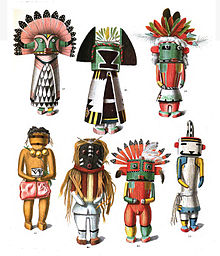
Back Качына (міфалогія) Byelorussian Качина Bulgarian Kachina German Kachina Spanish کچینا Persian Kachina (mythologie) French Kachina Croatian カチナ Japanese Kachina Malay Kaczyni Polish


A kachina (/kəˈtʃiːnə/; also katchina, katcina, or katsina; Hopi: katsina [kaˈtsʲina], plural katsinim [kaˈtsʲinim]) is a spirit being in the religious beliefs of the Pueblo people, Native American cultures located in the south-western part of the United States. In the Pueblo cultures, kachina rites are practiced by the Hopi, Hopi-Tewa and Zuni peoples and certain Keresan tribes, as well as in most Pueblo tribes in New Mexico.
The kachina concept has three different aspects: the supernatural being, the kachina dancers, and kachina dolls (small dolls carved in the likeness of the kachina, that are given only to those who are, or will be responsible for the respectful care and well-being of the doll, such as a mother, wife, or sister).[2]
- ^ Sacred Women in North American Rock Art, August 20, 2011. Image is from the Bureau of American Ethnology 21st Annual Report.
- ^ Colton, Harold Sellers (1959). Hopi Kachina Dolls: with a Key to their Identification (rev. ed.). Albuquerque: University of New Mexico Press. pp. 1–3.
© MMXXIII Rich X Search. We shall prevail. All rights reserved. Rich X Search